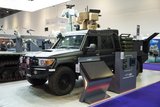Harris Corporation and ITT Corporation team to accelerate availability of soldier radio waveform
Harris Corporation and ITT Corporation are collaborating to accelerate the fielding of the Soldier Radio Waveform, a central piece of the US Department of Defense vision for a networked digital battlefield.
Harris and ITT have successfully exchanged voice and data between the Harris Falcon III AN/PRC-117G manpack and ITT's Soldier Radio development model using the specified SRW Version 1.01.1C. This is the first time that independently developed tactical radios have interoperated using open-standard wideband JTRS technology. Both the AN/PRC-117G and ITT's Soldier Radio were developed under the JTRS Enterprise Business Model, which is designed to spur innovation in tactical communications.Harris' rapid implementation demonstrates the portability of SRW.
The Soldier Radio Waveform is being developed to serve as a standard for wideband tactical communications for the US Department of Defense. SRW will deliver voice, data, and high-bandwidth networking capabilities to forces at the tactical edge.
Following the success of the exercise, Harris plans to conduct additional testing to include additional SRW features, such as communications security and SRW Network Manager integration. The company is integrating SRW into the AN/PRC-117G manpack, with release expected next summer.
"Harris and ITT have validated the utility and portability of SRW and are accelerating its availability to warfighters as part of a joint tactical wideband data radio network. This demonstrates the benefits of the JTRS Enterprise Business Model," said Brendan O'Connell, president, Department of Defense business, Harris RF Communications. "The successful exchange of voice and data over SRW illustrates the ability of the AN/PRC-117G to add standard US Government waveforms from the JTRS information repository through technology insertion."
The Harris Falcon III AN/PRC-117G is the first wideband manpack radio system with a JTRS-certified Software Communications Architecture and NSA Type-1 certified information security. The radio's wideband architecture enables applications such as streaming video, simultaneous voice, and data feeds, collaborative chat, and connectivity to secure networks such as SIPRNet, providing warfighters and field commanders with critical real-time information through a man-portable radio that is significantly smaller, lighter and more capable than legacy units.
The ITT Soldier Radio is a next generation of software-defined wideband communication capability for the dismounted soldier that provides dynamic ad hoc networked voice and data under all combat conditions. This Soldier Radio leverages on the maturity of ITT-developed SRW--with several years of field experiments, demonstrations and tests, including the most recent 36-node test at Fort Dix--and ITT's advanced technology optimized for low size, weight, power and cost. ITT's insertion of advanced hardware has enabled simplified portability and higher waveform performance. Given the proven maturity, scalability and performance of SRW, and the ubiquity of SRW in the Army's architecture, the ITT Soldier Radio will enable the warfighter to achieve an affordable network centric capability for the dismounted Soldier.
Source: Harris Corp
More from Digital Battlespace
-
![Babcock nears first customer for Nomad AI translation tool]()
Babcock nears first customer for Nomad AI translation tool
Nomad can provide militaries with real-time intelligence, saving critical time on the battlefield.
-
![AUSA 2025: Israel’s Asio Technologies to supply hundreds of improved Taurus tactical systems]()
AUSA 2025: Israel’s Asio Technologies to supply hundreds of improved Taurus tactical systems
Taurus operates alongside the Israel Defense Forces’ Orion system which supports mission management across tens of thousands of manoeuvring forces, from squad leaders to battalion commanders.
-
![AUSA 2025: Kopin pushes micro-LED plans as China moves faster]()
AUSA 2025: Kopin pushes micro-LED plans as China moves faster
The plan for the new displays follows fresh investment in Kopin’s European facilities by Theon and an order for head-up displays in fielded aircraft, with funding from the US Department of Defense.
-
![AUSA 2025: Persistent Systems to complete its largest order by year’s end]()
AUSA 2025: Persistent Systems to complete its largest order by year’s end
Persistent Systems received its largest ever single order for its MPU5 devices and other systems earlier this month and has already delivered the 50 units to the US Army’s 4th Infantry Division.
-
![Aselsan brings in dozens of companies and systems under the Steel Dome umbrella]()
Aselsan brings in dozens of companies and systems under the Steel Dome umbrella
Turkey has joined the family of countries attempting to establish a multilayered air defence system with government approval in August 2024 for the effort landed by Aselsan. Dubbed Steel Dome, the programme joins Israel’s Iron Dome, the US Golden Dome, India’s Mission Sudarshan Chakra and South Korea’s low-altitude missile defence system.
-
![DSEI 2025: MARSS unveils new agnostic multidomain C4 system]()
DSEI 2025: MARSS unveils new agnostic multidomain C4 system
MARSS’ NiDAR system has been deployed using sensors from static platforms to provide detection and protection for static sights, such as critical infrastructure, ports and military bases.




























